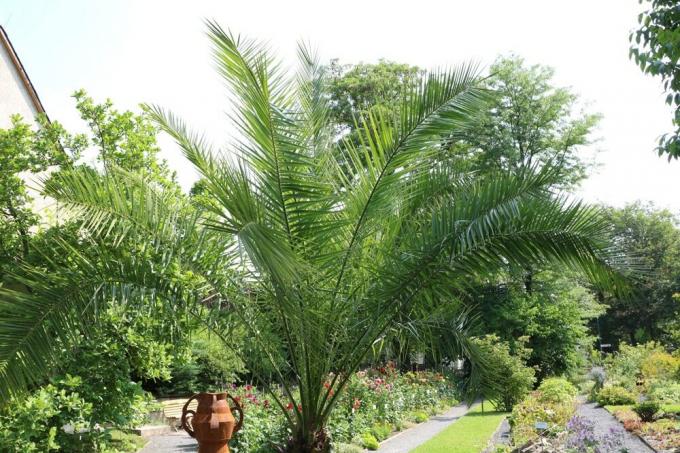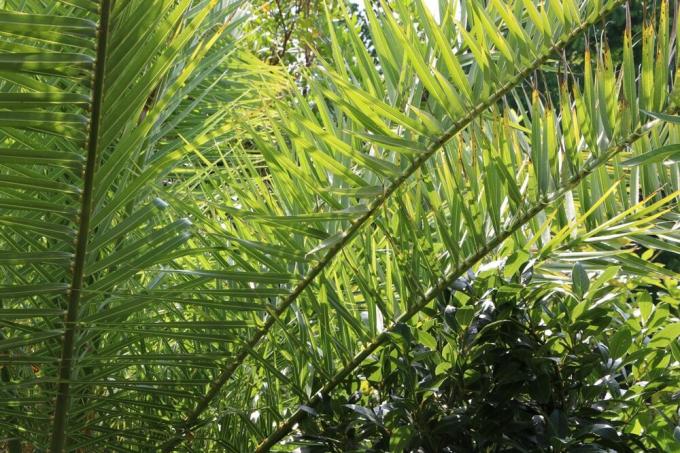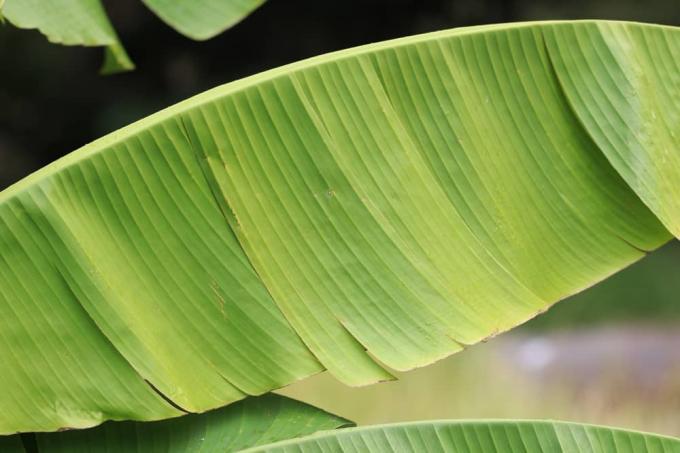

Table of contents
- Location & plant substrate
- Plant
- Plant out in the garden
- watering & fertilizing
- Leaves, flowers & growth
- Cut
- hibernate
- multiply
- Diseases & Pests
- crop
- Worth knowing about the Canary Date Palm
- Conclusion
Phoenix canariensis, as it is botanically named, is the most popular tub palm. Fast-growing, robust and easy to care for are characteristics that many fans of the palm tree appreciate. With its long fronds and feathers, it makes an imposing impression even with its small size and brings southern flair to the garden or to the balcony and terrace. Since their fronds can grow several meters long, Phoenix canariensis needs sufficient space. Cultivation as a houseplant is possible, but the Canary Date Palm is more happy about a summer outdoors.
Location & plant substrate
The original home of the Canary Date Palm is Asia and West Africa. Today it is endemic to the Canary Islands. It is cultivated in many southern regions. As a houseplant, it is only suitable to a limited extent. The outdoor season not only promotes growth, but also reminds the palm of its homeland, the Canary Islands - its botanical name, like its common name, is program. However, depending on the type of cultivation, the Canary Date Palm prefers different temperatures and locations:
- Outdoors: Full sun and sheltered
- Outdoor season from spring to autumn
- As a houseplant: bright living spaces with normal temperatures
As a container or houseplant, the palm tree needs light, permeable and acidic soil. She feels particularly comfortable in a compost-based substrate enriched with sharp sand, expanded clay and gravel. This additive ensures a drainage function and ensures aeration of the roots. A drainage layer should be laid at the bottom of the bucket so that excess water can drain away.
Tip:
The substrate mixture should be around 2/3 clay soil and 1/3 leaf compost. The palm does not like a substrate of pure humus. As this gradually collapses, even their roots can suffocate. As the palm grows, the proportion of loam should be increased so that the plant becomes more stable.
Solitaire or in the neighborhood?
The Canary Date Palm only achieves its special effect as a solitary plant.
Plant
Palm trees develop taproots that grow vertically downwards. This helps them to access important water reserves in the soil in nature. Therefore, the palm tree is happy about a high planter. The Canary Date Palm does not have to be repotted every year. However, if the upper roots grow out of the bucket, this is a sign that the palm tree is getting too tight in the bucket. Then at the latest the Canary Palm should be repotted.
- In the spring, repot into a larger and taller vessel or bucket
- Carefully remove old soil
- Place palm in new substrate
- Enrich with gravel or expanded clay
- Create a drainage layer in the bucket, approx. 5 cm
Tip:
The Canary date palm looks particularly pretty in a wooden container. For older plants, repotting every four years is sufficient. If you want to slow down the growth, the roots can be easily cut back.
Plant out in the garden

Older Phoenix canariensis can be planted out in the garden as long as temperatures do not fall below minus 6 degrees in winter. After a few years, their long taproots have reached the water table. From then on, the Canary Palm provides itself with water and additional watering is not necessary.
watering & fertilizing
The Canary Date Palm forgives major mistakes when watering. Although it needs a lot of water, it also survives shorter dry periods. However, the amount of water and fertilization have a major impact on growth. The more water and fertilizer the plant receives, the faster it grows. Reducing water and fertilizer will slow growth, but please never let the palm dry out completely or starve. The irrigation water and fertilizer information refers to rapid growth:
- Fertilize every two weeks during the main growth phase
- Add liquid fertilizer to the irrigation water according to the instructions
- Water evenly from spring through fall
- Root ball must be completely moistened
- No waterlogging
- Watering interval: the top layer of soil must be dry, every two to three days in summer
- Do not fertilize during hibernation
Tip:
Avoid calcareous water, palm trees don't like that very much. Smaller specimens can also be dipped into the water together with their pot in summer. In this way, the earth can soak up water and the palm tree has a sufficient water supply.
Leaves, flowers & growth
Strictly speaking, the Canary Date Palm has rather inconspicuous flowers and develops fruit for reproduction. It is particularly popular with us because of its tropical flair and rapid growth. In this way, the palm reaches a height of two meters in a short time. The trunk develops from the wreath of cut leaves. If the palm tree is not growing properly, it often needs fresh soil or more fertilizer.
The fruits of the Canary Island date palm are considered inedible. They develop from the yellow inflorescences, but Phoenix canariensis, which are cultivated in tubs, rarely flower. In nature, the popular avenue and park palms only flower from the age of 25. Dry infructescence and withered flowers should be cut off. Make sure that the cut is not too deep. The oval fruits grow in dense clusters and are orange to red in colour.
- feather palm
- Fine pinnate leaves
- Width of the leaflets: up to 60 cm
- Long, spreading palm fronds with lush green, up to 3 meters long
- Evergreen plant
- Solitary stem, scaly
- Fast-growing: up to 50 cm per year
- Growth height in culture up to five meters
- Growth width: length of the palm fronds
- Growth form: upright
- Flowering period: May and June
Tip:
You can wipe smaller specimens with a damp cloth from time to time so that the fronds of the palm tree come into their own. Older and larger palm trees are happy if they are occasionally hosed down with a garden hose.
Cut

Even if the Canary date palm is quite forgiving of mistakes in care, it should not be cut back or even shortened, as it only has a single vegetation point. Brown leaves of the Phoenix canariensis should not be cut off until they are completely dry and parched. When cutting, the leaf must not be completely removed, but about three centimeters of the petiole must be left on the trunk.
Tip:
Phoenix canariensis develops thorns at the base of the palm fronds. Therefore, the plant should only be touched with gloves when repotting. Since the thorns do not fall off when the fronds have dried out, gardening gloves should not be forgotten when disposing of the cut fronds.
hibernate
If the Canary date palm is cultivated as a houseplant, it should be allowed to hibernate during the winter, as is the case with outdoor palms. The ideal winter quarters for the houseplant is bright and should have a temperature between 8 and 12 degrees Celsius. In this way, the houseplant is fooled into thinking that the seasons are changing. In order for the deception to succeed, the palm should be watered less during the hibernation and not fertilized. For example, a bright spot is suitable as winter quarters for the palm tree when cultivated as a houseplant Staircase or stairwell, as long as there is no cold draught, and the stairwell is not heated becomes.
For pot plants, the outdoor season ends with the announced first frost. The requirements of the Phoenix canariensis for their winter quarters are:
- A bright winter quarters
- A temperature of 5 to 10 degrees Celsius
- Water regularly but moderately
- Watering interval a week or more
- 2/3 of the substrate should be dry
- Avoid waterlogging
- The root ball should not dry out
- Outdoor season from April to October
In order to avoid the formation of mold, the winter quarters should be well ventilated and not too damp. Like all potted plants, the Canary date palm also has to slowly get used to the sun again after the winter has passed. A sun-protected location helps the palm tree to acclimate and protects its leaves from burns. After about two weeks, Phoenix canariensis can move to their summer location.
Overwintering as an outdoor plant planted in the garden is very time-consuming. It is therefore better not to plant the palm in frosty regions. In milder regions, the Canary Date Palm needs appropriate winter protection. The younger the plant, the worse it tolerates temperatures below zero.
- Pile leaf soil, brushwood and straw a good 20 centimeters high around the palm trunk before the first frost
- Air this insulating layer regularly at intervals of a few weeks
- The root ball needs enough oxygen
- Wrap the palm crown in bubble wrap
- Alternatively, put a jute bag over it
- To avoid mold growth, remove the cover for a few hours on warmer days
Tip:
A place in front of a window in the stairwell is also an ideal winter quarters for potted plants.
multiply
The Canary Date Palm is propagated by seeds. After purchase, these should be sown rather quickly, as their ability to germinate decreases over time. The best time for propagation is spring. Before sowing, soak the seeds in warm water. Place the seed one to two centimeters deep in the seed soil. Then keep moist and look for a warm place as a location. The ground temperature can easily be 25 degrees Celsius. After two to three months, the seed should start to germinate. When the time comes, a cotyledon emerges. Then it takes patience. The first palm frond is only formed after two to three years.
Diseases & Pests
Unfortunately, the otherwise robust palm is susceptible to pests like its peers. Spider mites, mealybugs and scale insects like to nest there. The latter occur mainly in winter when the palm tree is in a too warm place. In summer, the palm is particularly susceptible to pests, in addition to those mentioned, thrips can also join if the substrate dries out too much. Drying out does not harm the palm immediately, but a dried-out substrate is an invitation for the pesky pests. As a preventative measure, the palm should therefore be sprayed regularly with lukewarm water.

A particularly aggressive pest is the so-called red palm weevil. If it attacks the Canary date palm, it must be burned immediately. At the moment there is no need to worry about the palm eater in this country, but when the winters become milder and milder, it can also become a nuisance here.
If the palm tree gets brown leaves, this can have various causes.
- The irrigation water is too calcareous
- In winter, the palm gets too much and/or too cold water
- In the summer she gets too little water
crop
Phoenix canariensis is non-toxic. Nevertheless, the Canary date palm is used exclusively as an ornamental palm. The fruits are considered inedible, but can be used as feed dates for goats and pigs.
Worth knowing about the Canary Date Palm
Phoenix canariensis is a very common species of palm. This is due to their robustness and adaptability. It is the natural symbol of the Canary Islands and has been under strict protection since 1999.
Conclusion
The Canary Date Palm is very popular with hobby gardeners. The robust and easy-care feather palm is fast-growing and therefore soon achieves a stately appearance with its long fronds. The palm tree is best cultivated as a solitary container plant. The outdoor season is from spring to autumn. The palm tree should be brought inside before the first frost. Older palm trees can also be planted out in the garden. However, their frost hardness only extends to a maximum of minus 6 degrees Celsius. The Canary Island Date Palm needs plenty of water during the outdoor season, but it can also tolerate shorter dry spells. It should be fertilized every two weeks. If the rapid growth is to be curbed, the amount of water and fertilization can be reduced. In the bucket, the Phoenix canariensis needs slightly acidic plant substrate. The bottom of the vessel should be provided with a drainage layer to prevent waterlogging. Since the Canary date palm forgives major care mistakes, it is ideal for palm beginners.
 garden editorial
garden editorial I write about everything that interests me in my garden.
Learn more about potted plants

Abalie, Abelia grandiflora: 14 tips for proper care
The large-flowered abalia (Abelia grandiflora) is an extraordinarily easy-care ornamental shrub that delights with numerous funnel-shaped and subtly scented flowers. It is just as suitable as a background plant as a hedge or container plant.

Caring for the tangerine tree properly | 13 tips for the tangerine tree
Many citrus plants have evolved from the tangerine, one of the oldest and most original citrus species. With its white flowers and orange fruits, it is a feast for the eyes and the palate. In this country it is only cultivated as a container plant due to its sensitivity to frost.

Indian canna, Canna indica | 13 tips for care
Canna indica, also known by the botanical name Canna indica, is a decorative plant that not only enriches every garden during flowering. In pot culture, it can be used as an accent for many years thanks to its color and growth.

11 absolutely hardy container plants
Absolutely hardy potted plants have several advantages to offer, because they can remain outdoors even when the temperature is below zero and require little protection. If they are also evergreen, they can also bring joy all year round.

Is dwarf bamboo hardy? | 11 tips for care & cutting
Dwarf bamboo is one of the easy-care sweet grasses. In the garden, it can be used as a good ground cover, as it does not grow as tall as its larger relatives. Whether the plant is hardy and how it is cared for and cut can be read in the guide.

Pink dwarf banana, Musa velutina | Care of the Kenya Banana
The pink dwarf banana (Musa velutina) is an eye-catcher in the garden. It grows to a maximum of two meters and impresses with its impressive flowers. The small pink fruits taste sweet and aromatic. If you want to harvest the exotic fruits, you should follow our care tips.
